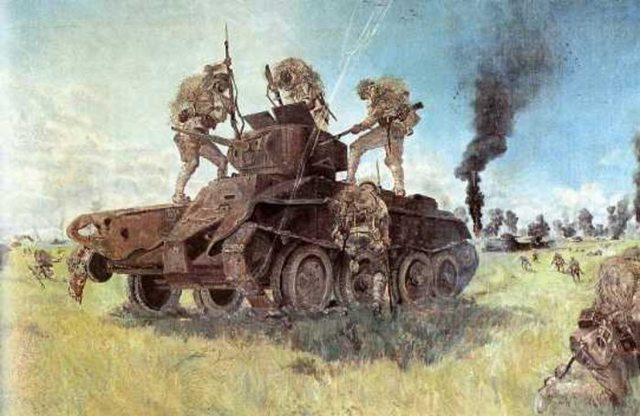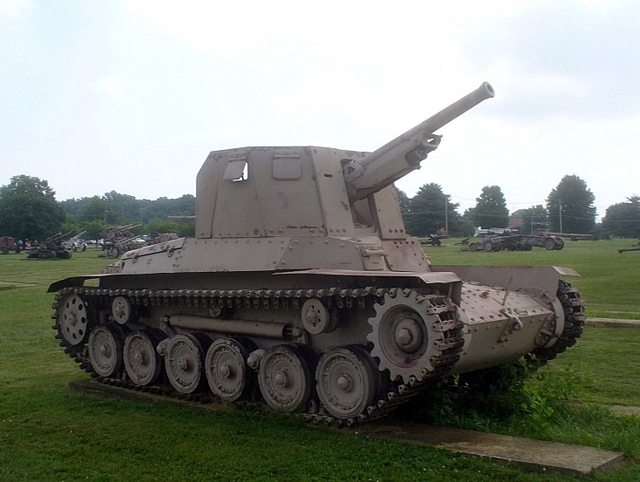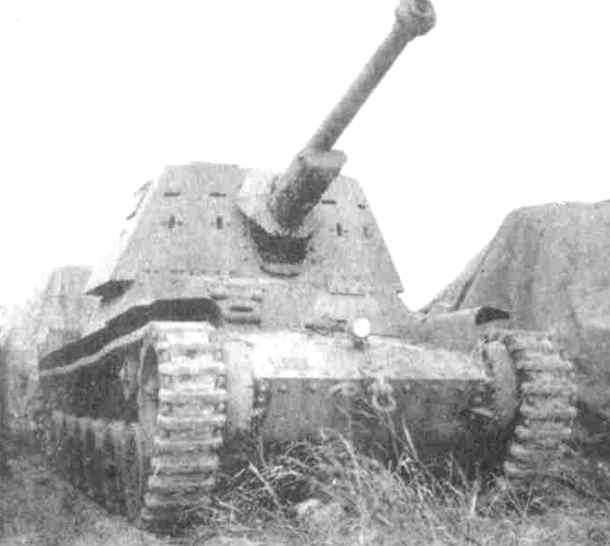Author: Daigensui (US server)
Today, we have another guest article, this time by Daigensui, who worked previously on getting info for the Japanese branch. She named the article…
Daigensui’s Rescript: Late Coming Early Days Japanese TD
This is Part 1 of the Japanese Tank Destroyer Series, dealing with the origins of tank destroyer development and the first results. Before we look into the beginnings of the pretty meager collection of Japanese tank destroyers, we need to first understand how tank destroyers came about.
The first tank destroyers were basically stopgap solutions, mounting an anti-tank gun on a tracked vehicle and calling it a dedicated anti-tank weapon. The German Panzerjägers, anti-tank guns in an open-topped superstructure on a light tank chassis, were the major starting point for this idea. The existence of heavy French tanks like the Char B1, which were beyond the capabilities of the major anti-tank guns in service, meant that the Germans needed larger guns on mobile platforms. That is how Panzerjäger I and the Marder series came about: putting larger anti-tank guns on tank chassis to give them the mobility to keep up with the rest of the armored forces. It was only as the war went on that with more powerful tanks coming to the battlefield that we have the appearances of casemates on medium/heavy tank chassis armed with powerful guns.
Now, considering this background, one has to put onself into the mindset of the Imperial Japanese Army to understand why Japan was never too keen on developing tank destroyers. When your current enemy barely has any armor to speak off, and you have a non-aggression treaty with potential enemy to the north (which you fought before, and realized that your current towed anti-tank guns were adequate for the job), why would you go through the trouble of trying to stick larger guns on your already limited tank chassis? After all, your 37 mm Anti-Tank Gun Type 94 could just about deal with anything in your path, including those Western powers in Southeast Asia with their Universal Carriers, Lanchester Armoured Cars, Carden Loyd Tankette, and Stuarts. Your industrial capacity is already strained to the breaking point with a massive continental war. So, why bother with this tank destroyer nonsense?
Obviously, when you realize that perhaps one or two of those enemies might be bringing something more protected.
Contrary to what many think today, Japan did learn quite a few lessons in the clashes with the Soviet Union. These were consolidated into Nomonhan Research Report, a classified candid document not meant for public consumption, but intended for the use of staff officers who would be charged with implementing the recommendations. Of course, most of the suggestions were ultimately not implemented as it should have been, due to the core lack of industrial capacity Japan was facing during its entire time as an empire. Regardlessly, the document did have great influence over Japanese armor development, and would be the background for the making of the Japanese tank destroyer force.
Perhaps the silent complaint noted in the report was the lack of sufficient anti-tank weapons, be it the towed guns or tanks. In fact, one part noted that the troops would be annihilated without such weapons in case of a future attack, and endorsed research to design a more powerful anti-tank gun that would be necessary to defeat heavier armor likely to appear in the future. This lead directly to the development of the 47 mm Anti-Tank Gun Type 1 and its adaptation for use in Type 97 Chi-Ha Kai.
The findings in the Nomonhan Research Report also endorsed the concept of making the anti-tank weapon the nucleus of the infantry formation, along with with suggestions for the need for a self-propelled gun as part of a comprehensive renovation of artillery. While ultimately the organic artillery of Japanese infantry divisions became so bewildering as to defy the notion of standardization, self-propelled guns did begin to appear in Japanese units. The first one, born from the fire of the Mongolian plain, was Type 1 Ho-Ni I.
Type 1 Ho-Ni I was developed by using the existing Chi-Ha chassis and engine, and replacing the gun turret with an open casemate with frontal and side armor only, while applying extra armor to the front hull. Basically, it followed the Panzerjäger idea, sticking a larger gun onto an existing tank chassis. In line with the need for both a good anti-tank weapon and self-propelled gun, Ho-Ni I was designed to operate as self-propelled artillery in the armored divisions while being armed with a relatively high-velocity gun for anti-tank purposes.
One might ask why it took almost two year (development started in December 1939 and acceptance was in October 1941) for such a simple vehicle to come out. As it turns out, clashes about the purpose of this “gun-tank (housensha)” was the main reason for the delayed development. At least there was the simple lack of any suitable anti-tank gun until 47 mm Anti-Tank Gun Type 1 came along. Aside from this, there was the disagreement on whether this gun-tank should be purposed for anti-tank or artillery purposes. The anti-tank/artillery argument was only settled after the decision to make a separate self-propelled gun armed with a 10.5 cm howitzer (Ho-Ni II) for pure artillery purposes, with Ho-Ni I providing both long-range direct fire and anti-tank capabilities with a modified 75 mm Field Gun Type 90.
Ho-Ni I served mostly with the 2nd Armored Division in the Philippines, where while it did not have a big impact on the battlefield, was still able to do its job sufficiently for such an outdated design. It was one of the few vehicles that could defeat a Sherman, with the veterans of the Japanese-Soviet conflicts carrying out camouflage and ambushes, managing to destroy M4 tanks from around 500 meters away. In the end, all Ho-Ni Is were destroyed, with only one example surviving in the United States.
For the Imperial Japanese Army, however, Ho-Ni I was not enough. In order to solve the issues of crew survivability, a fully enclosed and armored casemate was made for the upgrade, Ho-Ni III, in 1943. In addition to this, with the case mate having its flanks protruding beyond the hull sides, it provided more room for the crew and the possibility of upgunning, although such upgunning never happened due to lack of resources. Also, the gun was changed to 7.5 cm Tank Gun Type 3 Model II, a modified version of 7.5 cm Field Gun Type 90 for use in gun carriers. The breech was shorted by 300 mm to allow greater traverse (22° to each side) and elevation (-15°/+25°).
Unfortunately, unlike Ho-Ni I, Ho-Ni III was kept on the Home Islands for the “Decisive Battle” against the Allied invasion, thus never being used in actual combat.
This was just the beginning of Japanese tank destroyer development. While the beginnings were humble, the start of the Pacific War meant that Japan needed more powerful vehicles, and thus began rapid improvements…..






FIRST! *donkey*
Thanks for this amazing article
I abuse of this first comment to ask a question: How the f*ck did the Army Ordnance Museum get so many rare AFVs? I mean, Pz.IV Hydro, Grille, this Japanese Ping-Pong II tenk and why is there no trace of the E100 hull that the brits found?
And where is the Char 2C, GW. Tiger and other prototypes?
I smell Illuminaty.
And where the f*ck are my manners? Very pleasant lecture, well elaborated article, good work!
UK scrapped the E-100 hull, the Char 2C did not survived the war:
http://ecache.ilbe.com/files/attach/images/377678/929/800/159/346fc739df2279d35154e12d85a9ea4b.jpg
Thanks for the information!
It’s a terrible shame that they scrapped this peace of ingenuous art. Weren’t there rumors that Kubinka was hiding a 2C somewhere in a hangar?
I heard a theory a while back that one of the Char 2C’s was captured by the Germans and used as propaganda, after the war the Soviets captured it and now it is somewhere in Kubinka
didn’t notice the last part of that…ninja’d
US scrapped its Karls and scrapped a large number of prototypes both from the US and from other countries.
after the war the allies scrapped and destroyed many fine prototypes and beautiful machines. Many crops were lost… Bastards
Oh oh oh, awesome article Daigensui-sama :D :D I Can’t wait for the next part :)
“Ho-Ni, I’m home!”
“O-I, what took you so long?”
“They killed Ke-Ni, had to mourn him :)”
Thats Ho-Rible!
They were Chi-To-rs!
Oh no, I got STA/B-! in the back!
did you Grille them hard, for information?
Hummel let you finish, but the M7 Priest was the best SPG of WW2.
Te-Ke chill pill with these puns, guys…
You know you Lowe this conversation.
I think I´Marder leave
My favorite pokemon is CHAR MARDER.
I have to go, it’s already five past Casillas and my Ho-es are waitin’.
Chi-Ri-O chaps
Such shame there’s no info on chinese TD’s other than very few pics from WG itself… anyway, good article, I enjoyed reading it.
“elevation (-15°/+25°)”
Nice
“The breech was shorted by 300 mm to allow greater traverse (22° to each side) and elevation (-15°/+25°).”
Japanese seem to have been obsessed with gun depression+traverse from the very beginning >_>
It probably has something to do with the terrain there. Japan and its isles consists mostly of mountains and forrests. So when you need tanks for that kind of terrain, you need small and light tanks with good gun depression and elevation.
Considering it seemed to pursue an expansionist policy, would they have considered fighting in their home islands or would they have designed their equipment with foreign territory in mind?
On first sight I would say that they would still need light tanks with good gun depression and elevation. Mediums might be usefull on some places but I don’t think there’s terrain close to Japan where heavy tanks would be usefull, unless someone can tell me otherwise.
Nice article! Allthough I do not totally agree with the small history of tankdestroyers..The were multiple reasons to build them:
1. make use of old tankfactories (Pz 38t, PzII, PzIII)
2. flank and counter massive breakthroughs by enemy tanks (All US TD’s)
3. Give Antitank power to mobile units (polish TD’s in recce-companies)
4. make something usefull of old existing tanks
and actually at least Guderian never understood why Hitler wanted an elefant instead of a tiger, or a Kingtiger instead of a Tiger2. It doesnt fall into any category named above…
Considering that Japan didn’t have the luxury of recycling it’s old and outdated tanks and had to keep using them due to lack of production…you can sort of understand why they’re not too keen on the whole idea of using them as tank destroyers.
Aren’t the KingTiger and the Tiger2 the same thing?
Oops, of course I meant the JagdTiger and the Tiger2/Kingtiger.
If you can build a Kingtiger why build a Jagdtiger instead? And actually, the jagdtigers indeed didnt do much in WW2
Lol, japs. Can’t imagine what would they do when greeted with lets say.. KV-2 in the early years. Did they had something similar to german 88s that could be towed near the KV as a last resort to deal with it? So far it looks like these bamboowagons armed with knock-knock guns could be tier T2/3 tops.
They had an 88 mm AA gun as a matter of fact (which was considered for use on the Chi-Ri, but they settled on a 75 mm AT gun instead)
Yeah if this line and others will appear at all. But nice article anyway :)
Judging from pictures, tier II Japanese TD will be four chaps banging enemy tanks with stocks of their rifles?
Seems about right. Also can use sharpened bamboo sticks as premium ammo.
If the HTs & MTs Japos are paper armor, imagine these TDs … the best HE targets ever.
And their SPGs will have negative armor?
New german waffle line is not different :D
Low pen tank need their exp too, i guess.
Hey, the US tested that method too.
Whatever works.
Wonderful article, looking forward to the next part(s). Thank you Daigensui!
Very very sad picture… http://ftr.wot-news.com/wp-content/uploads/2014/06/Y7hGfmSl.jpg